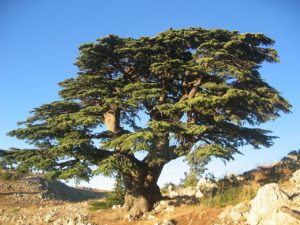
The sun is setting, orange and pink rays are caught by the darkened clouds. It is the Sabbath. In synagogues all over the world, Jews greet the Sabbath with psalms and songs. “Tzaddik k’tamar yeefrach, k’erez balvanon yisge. The righteous shall flourish like the palm tree, he shall grow like a Cedar in Lebanon” (Psalm:92:12).
The Hebrew Bible abounds in botanical imagery. The Cedar of Lebanon stands close to 115 feet high with strong, deep roots and a wide canopy of branches, the oldest Cedars are thousands of years old. These trees are resilient and useful. The righteous person stands tall and proud with wide arms to embrace all. The righteous person stands in this world with deep roots in traditions and a crown of branches reaching to the heavens.
Over the centuries the cedar tree has been exploited. From the Phoenicians to the Israelites, from the Babylonians to the Turks, the precious cedar wood has been chopped down to build our Holy Temple, fleets of ships and more recently, railroad tracks that connected the Ottoman Empire. From as far back as the time of the Emperor Hadrian people have tried to protect the cedar forests. In 1876, Queen Victoria even built a wall around a 250 acre grove to protect the trees.
Today these trees are once again threatened. As temperatures rise in the Middle East, the ecological comfort zone moves further up the Lebanese mountains to higher altitudes. The increase in temperatures has also brought new insect infestations and these old, resilient trees are dying off.
An Aggadic Talmudic commentary of a verse in Ecclesiastes offers: “When the Blessed Holy One created the first human, He took him and led him round all the trees of the Garden of Eden and said to him: Look at My works, how beautiful and praiseworthy they are! And all that I have created, it was for you that I created it. Pay attention that you do not corrupt and destroy My world: if you corrupt it, there is no one to repair it after you.” As Rosh Hashanah approaches we are told repeatedly to choose life. The cedar tree reminds us, both physically and metaphorically of our responsibility to all life on this increasing fragile and vulnerable planet.